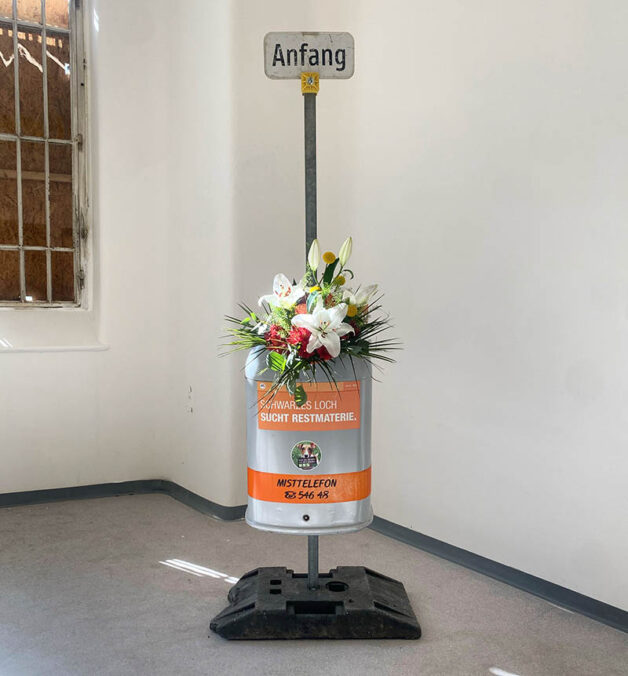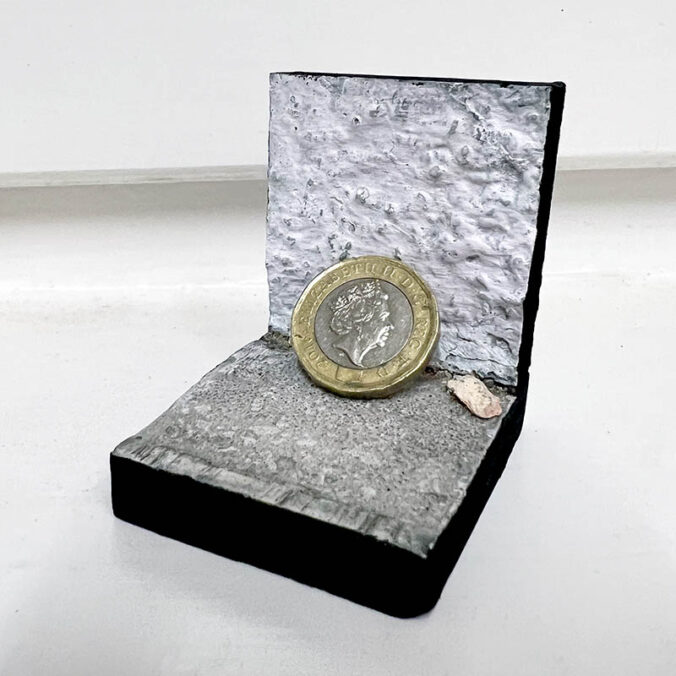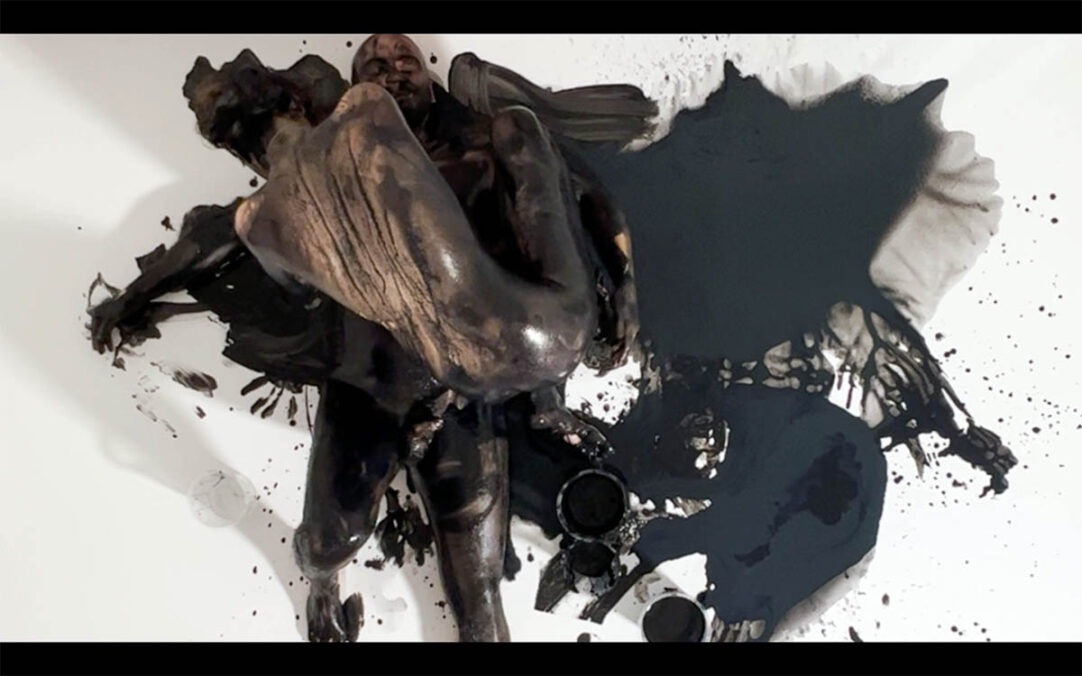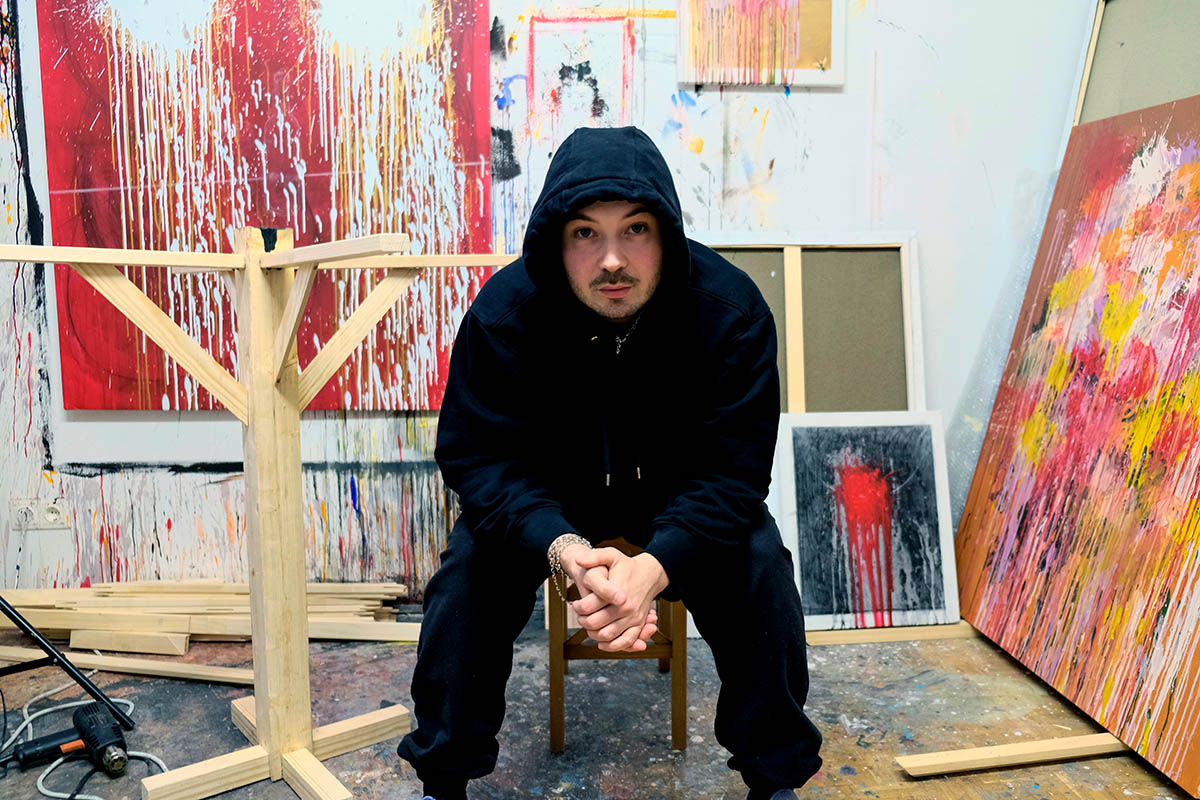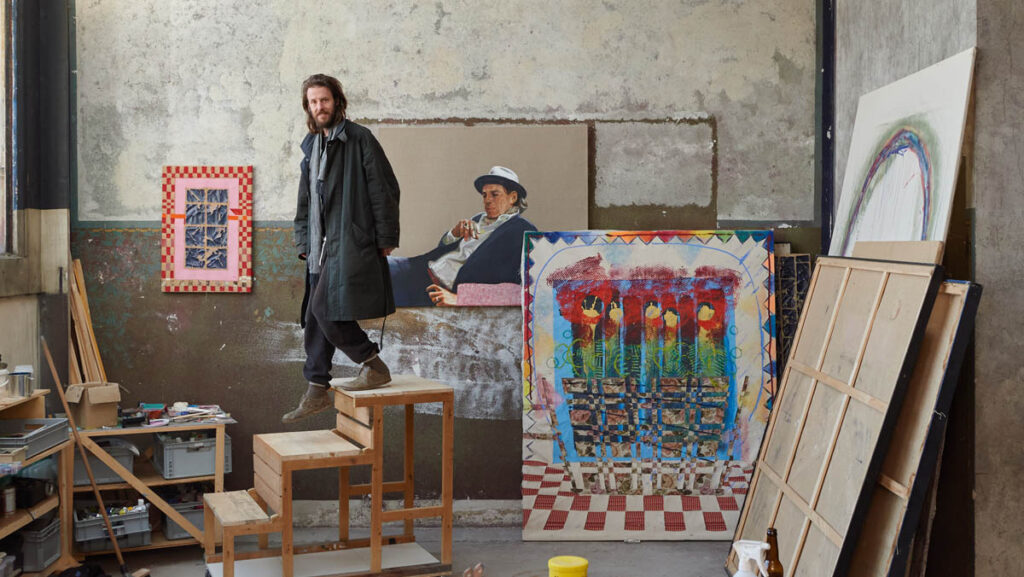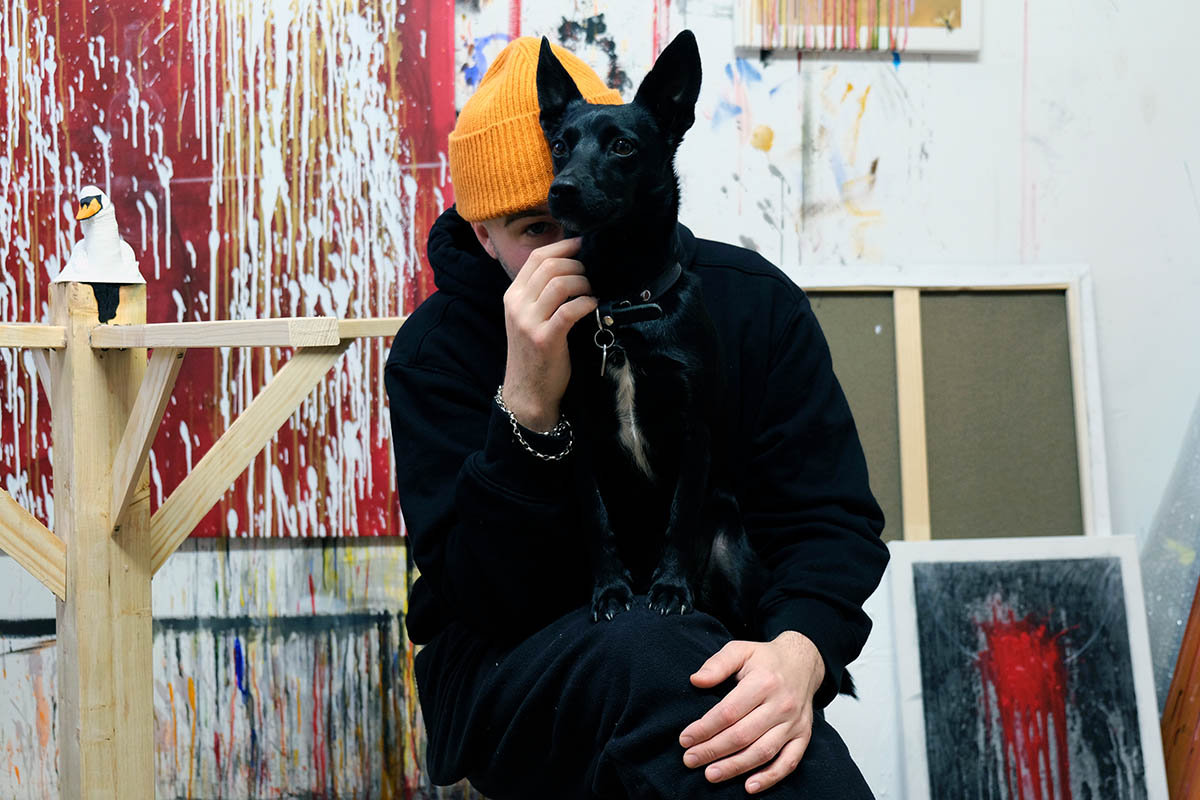
Joseph Sakoilsky [born 1992, London UK], lives and works in Vienna. He works with mixed media, painting, sculpture, and performance art. Associating with post-radical actionism. How did he come across Herman Nitsch’s work? What does his latest body of work, ‘Punch paintings, ’ express? What areas of Vienna remind him of his childhood flat in London?
Erka Shalari: You have a long history with Vienna, it isn’t new, even though you have only lived here for two years, the relationship actually began when you were a child isn’t that right? Could you share some memories with us?
Joseph Sakoilsky: Yes that’s correct, the relationship with Vienna is established through my father and his close friend, cultural father figure Herman Nitsch. As such I have visited Vienna most years since the age of 22.
I have been surrounded by Herman Nitsch’s work since I was a young child. My father filled our entire house with the images of Nitsch’s performance, whilst writing a thesis and curatoring the first Nitsch exhibition in London in the 90’s.
As a child I was scared yet compelled to keep looking at the images which resembled autopsies or mutilations, a sort of fascination of the unknown. I guess because my sister and I were both probably equally disturbed by the images, my father would try to explain to the then 5 & 7 year olds not be afraid as this is art.
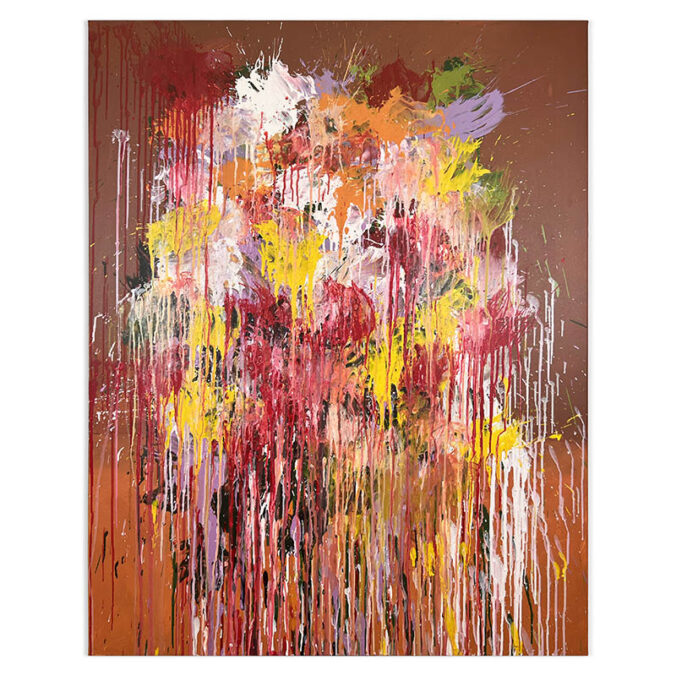
Punch bouquet, 2023 – Acyrlic paint on canvas – 120 x 160 cm
When did you start painting?
I have always painted, it was never my main medium. I previously concentrated on small scale sculptures and predominantly drew with inks. However, in the last two years, since living in Vienna I have really had the space and freedom to freely express and create larger paintings. Of which I have enjoyed being able to use any method of applying material to material. I no longer am restricted to painting small paintings with a brush or scribbling on paper, I feel somewhat free.
You are not fixed to one medium, how do you decide which medium to work with?
I am keen to work across mediums, as the work I want to make and how best to translate the feelings, intensity or emotions is very different depending on whether I make paintings, sculptures or performance. My use of materials adapt to the necessity of creation, not the other way around. The idea gives birth to experimentation with new materials.
Do you work simultaneously across a number of works at one time?
I am normally working on one series of work at a time. However, boundaries can indeed blur and the translation from one cycle of work to the next is a dynamic process for me. Although an idea may be strong, it may take multiple attempts until I feel the piece is truly finished and I am able to let it go. The possibility of improvement often leads me to revisit works that I thought were finished. It’s an endless battle between my conviction to let a work ‘breathe’ and the theoretical hope that the next brush stroke or retake may be better…
5 x 5 x 6cm
The mundane plays a crucial role in your life. Can you tell us something about your inspiration?
I find beauty in the overlooked everyday object/s, from paint rags to bins/shipping pallets/cracks..etc. I enjoy recreating inconspicuous and seemingly meaningless objects, asking the viewer to look again with me, by elevating the everyday object to the staging of a white walled gallery – it adds a gravitas to the piece, people have to stop and look again.
One man’s trash, one man’s sculpture. Take for example: ‘Stop and smell the flowers’ a sculpture I created – the title plays on an old English idiom. It means to take time out of one’s busy schedule and appreciate life, and the fleeting moments. The sculpture, which consists of a Viennese cigarette street bin – serving as a vase for a bouquet of fresh flowers. It is a ready made I discovered walking through the first district, someone had carefully placed the flowers in the bin. At the time, I read this as a story of a broken relationship, or a failed attempt of an apology. Either way, it’s an image that prompts people to make associations. I find beauty in these small moments of everyday life, the small things which make us smile or wonder momentarily with the possibility of changing our mood for the rest of the day.
What does your atelier look like?
My wife Kata Oelschlägel and I share a studio, which is currently filled with new works and ideas, as we are both very busy this year with a series of upcoming exhibitions. The studio is nestled in a quiet area of Vienna, a quiet haven from the city, paintings and works fill almost every space currently, from religious iconography to transhuman skeletal sculptures the studio feels like a constant living installation.
Vienna! – What is it that fascinates you most? How would you describe the city? Are there any locations that remind you of London?
I’m mainly fascinated by Vienna being closed on a Sunday!! Although sometimes this can be a pain, I understand the beauty of getting to rest and spend the day with family…. I think I’d still prefer to be able to buy groceries…
I love being able to experience a new city and I am constantly childlike discovering great new things and places around Vienna, such as Trzesniewski, Rüdigerhof, buschenschänken, the danube, Kleines cäfe, würstel stands, etc etc. There’s so much I love and so much still yet to discover.
I grew up in a social housing in Camden, London, so I love to see the social housing areas of Vienna, of which I understand to be very successful. Kata and I had a residency in the 16th district for 3 months during the summer of 2023, nestled between social housing. I came to love this area and found it very reminiscent of what I would call my London.
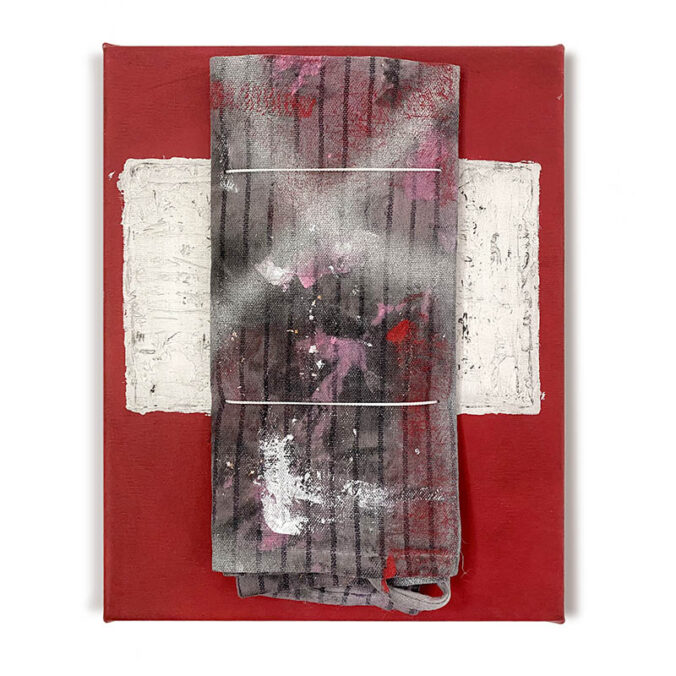
Cross rag, 2022 – Rag and acrylic paint on canvas – 24 x 30cm
I love being able to experience a new city and I am constantly childlike discovering great new things and places around Vienna, such as Trzesniewski, Rüdigerhof, buschenschänken, the danube, Kleines cäfe, würstel stands, etc etc.
Please could you talk about your series ‘Punch Paintings’?
The punch paintings are a series of actionistic works I have been working on for the best part of a year. The idea came from an immature coping mechanism from my childhood. Like many other young teenage boys do, when encountering anger or frustration, I would punch a wall in anger. As a teenager, I found it extremely difficult to express myself, I didn’t have the easiest upbringing and so I guess anger was and is valid. Sometimes, I would punch walls repeatedly until my knuckles would leave a bloody trail on the walls. I found a sort of peace in this, and although looking back now it’s obviously stupid and somewhat ridiculous teenage outcry. I think that anger and fear, and hatred be it towards oneself or to another, is merely a facade to a deeper vulnerability.
Re-evaluating this period in my life, and my own feelings at the time, I created these works with the core idea of removing the emotion of anger from the act of punching. There is no adrenaline when I punch, I feel every punch, each more than the last.
I do not use padding and I punch the canvas directly against a solid concrete wall. So each punch I feel the pain, I guess you could consider it a way for me to come to terms with my teenage self, and also express that I do hear that anger. I hear it and raise it a painting!
This summer you have a solo exhibition at the Nitsch Foundation, how does it feel? and what works will you be exhibiting?
Yes the exhibition is titled: ‘FROM PAIN COMES PAIN, THEN LAUGHTER’ and it’s part of a series of exhibitions titled ‘A Homage by….’ and it’s opening on 28th June. I am so excited to exhibit with the Nitsch Family, I have been influenced by Nitsch and really appreciate this opportunity.
The ‘punch paintings’ will be exhibited, alongside other new works and performance pieces. The concept of the show is that we all suffer, some of us just learn to laugh after.
Exhibition: NITSCH. A Homage by Joseph Sakoilsky: FROM PAIN COMES PAIN, THEN LAUGHTER
Exhibition duration: June 28th – July 26th 2024
Opening hours: Tuesday – Friday 10 am -6 pm Free admission
Address and contact:
Nitsch Foundation
Hegelgasse 5, 1010 Wien
www.nitsch-foundation.com



